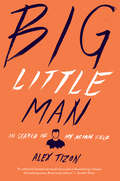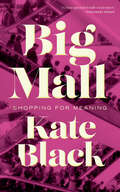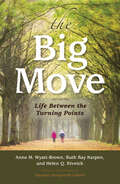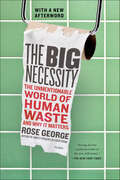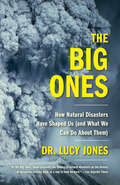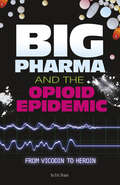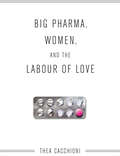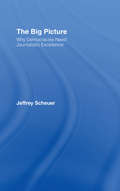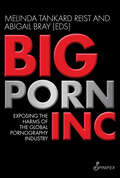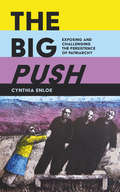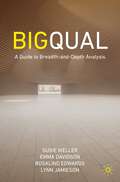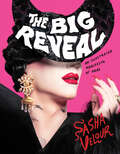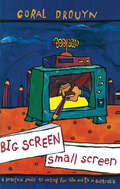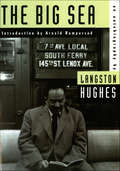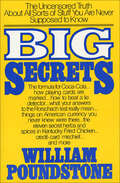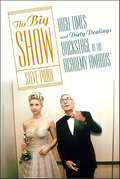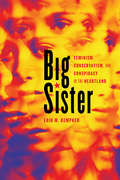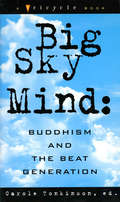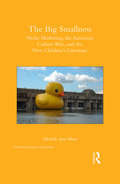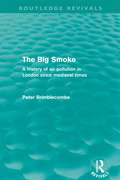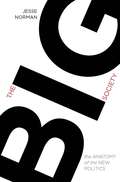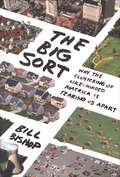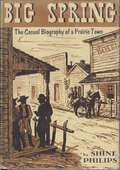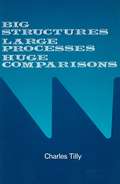- Table View
- List View
Big Little Man: In Search of My Asian Self
by Alex Tizon&“Alex Tizon fearlessly penetrates the core of not just what it means to be male and Asian in America, but what it means to be human anywhere.&”—Cheryl Strayed, New York Times bestselling author Shame, Alex Tizon tells us, is universal—his own happened to be about race. To counteract the steady diet of American television and movies that taught Tizon to be ashamed of his face, his skin color, his height, he turned outward. (&“I had to educate myself on my own worth. It was a sloppy, piecemeal education, but I had to do it because no one else was going to do it for me.&”) Tizon illuminates his youthful search for Asian men who had no place in his American history books or classrooms. And he tracks what he experienced as seismic change: the rise of powerful, dynamic Asian men like Yahoo! cofounder Jerry Yang, actor Ken Watanabe, and NBA starter Jeremy Lin. Included in this new edition of Big Little Man is Alex Tizon&’s &“My Family&’s Slave&”—2017&’s best-read digital article. Published only weeks after Tizon&’s death in 2017, it delivers a provocative, haunting, and ultimately redemptive coda. &“A ruthlessly honest personal story and a devastating critique of contemporary American culture.&”—The Seattle Times &“Part candid memoir, part incisive cultural study, Big Little Man addresses—and explodes—the stereotypes of Asian manhood. Alex Tizon writes with acumen and courage, and the result is a book at once illuminating and, yes, liberating.&”—Peter Ho Davies, author of The Welsh Girl &“This personal narrative of self-education and growth will engage any reader captivated by the sources of American, and Asian-American, manhood—its multitude of inheritances and prospects.&”—Minneapolis Star Tribune
Big Mall
by Kate BlackA phenomenology of the mall: If the mall makes us feel bad, why do we keep going back? In a world poisoned by capitalism, is shopping what makes life worth living?Kate Black grew up in West Edmonton Mall – a mall on steroids, notorious for its indoor waterpark, deadly roller coaster, and controversial dolphin shows. But everyone has a favourite mall, or a mall that is their own personal memory palace. It's a place people love to hate and hate to love – a site of pleasure and pain, of death and violence, of (sub)urban legend. Blending a history of shopping with a story of coming of age in North America's largest and strangest mall, Big Mall investigates how these structures have become the ultimate symbol of late-capitalist dread – and, surprisingly, a subversive site of hope."Speaking as a child of PacSun and Hot Topic myself, Big Mall is like a madeleine dipped in Orange Julius. Like a mall, the book itself has a lot of everything, a sublime mix of memoir, history, and cultural criticism. Kate Black is a learned Virgil in the consumerist Inferno, always avoiding the obvious and leading us to surprising connections—oil, suicide, Reddit, squatters, dolphins. Whether malls fill you with nostalgia or horror, this book will change your relationship to the world we've constructed around us.” – Tony Tulathimutte, author of Private Citizens"Before there was Instagram, there was the mall. But what happens when a seasonless, tacky, fantasyland is all you knew growing up? How does one embrace a genuinely fake experience? Or to be more precise, a fake but genuine experience? Kate Black’s Big Mall is a smart, sentimental, and perspective-shifting look at the outsized role that big malls play in modern life. Love ‘em or hate ‘em, one thing’s for sure: after reading this book, you’ll never look at a mall in the same way again." – Ziya Tong, Science broadcaster & author of The Reality Bubble
The Big Move: Life Between The Turning Points
by Margaret Morganroth GulletteWhen her husband's ill health forces them to move into an assisted living facility, Anne Wyatt-Brown suddenly finds herself surrounded by elderly residents, mostly sick or disabled. In this short but provocative collection, distinguished gerontologists reflect on Anne's moving account of her transition from a vibrant, independent, and scholarly life to one that is quieter, slower, and that takes up considerably less space. By questioning notions of care and community, stigmas of aging, and the psychological factors involved in accepting assistance, this volume provides an instructive framework for thinking about aging, continued care, and our last big move.
The Big Necessity: The Unmentionable World of Human Waste and Why It Matters
by Rose GeorgeAn “extraordinary” look at the stubborn problem of human waste disposal: “Among the best nonfiction books of the new millennium.” —The New York TimesAcclaimed as “valuable and often entertaining” (Los Angeles Times), The Big Necessity defies the taboo on bodily waste—something common to all and as natural as breathing. We prefer not to talk about it, but we should—even those of us who take care of our business in pristine, sanitary conditions. Disease spread by waste kills more people worldwide every year than any other single cause of death. Even in America, nearly two million people have no access to an indoor toilet. Yet the subject remains unmentionable.Moving from the underground sewers of Paris, London, and New York (an infrastructure disaster waiting to happen) to an Indian slum where ten toilets are shared by 60,000 people, The Big Necessity breaks the silence, revealing everything that matters about how people do—and don’t—deal with their own waste. With razor-sharp wit and crusading urgency, mixing levity with gravity, Rose George has turned the subject we like to avoid into a cause with the most serious of consequences.“One smart book . . . delving deep into the history and implications of a daily act that dare not speak its name.” —Newsweek“Makes a passionate argument for putting sanitation at the top of the world’s development agenda.” —Time“With irreverence and pungent detail, George breaks the embarrassed silence over the economic, political, social and environmental problems of human waste disposal. Full of fascinating facts . . . an intrepid, erudite and entertaining journey through the public consequences of this most private behavior.” —Publishers Weekly (starred review)
The Big No (21st Century Studies)
by Kennan FergusonWhat it means to celebrate the potential and the power of no What does it mean to refuse? To not participate, to not build a better world, to not come up with a plan? To just say &“no&”? Against the ubiquitous demands for positive solutions, action-oriented policies, and optimistic compromises, The Big No refuses to play. Here leading scholars traverse the wide range of political action when &“no&” is in the picture, analyzing topics such as collective action, antisocialism, empirical science, the negative and the affirmative in Deleuze and Derrida, the &“real&” and the &“clone,&” Native sovereignty, and Afropessimism.In his introduction, Kennan Ferguson sums up the concept of the &“Big No,&” arguing for its political importance. Whatever its form—he identifies various strains—the Big No offers power against systems of oppression. Joshua Clover argues for the importance of Marx and Fanon in understanding how people are alienated and subjugated. Theodore Martin explores the attractions of antisociality in literature and life, citing such novelists as Patricia Highsmith and Richard Wright. François Laruelle differentiates nonphilosophy from other forms of French critical theory. Katerina Kolozova applies this insight to the nature of reality itself, arguing that the confusion of thought and reality leads to manipulation, automation, and alienation. Using poetry and autobiography, Frank Wilderson shows how Black people—their bodies and being—are displaced in politics, replaced and erased by the subjectivities of violence, suffering, and absence. Andrew Culp connects these themes of negativity, comparing and contrasting the refusals of antiphilosophy and Afropessimism. Thinking critically usually demands alternatives: how would you fix things? But, as The Big No shows, being absolutely critical—declining the demands of world-building—is one necessary response to wrong, to evil. It serves as a powerful reminder that the presumption of political action is always positive.Contributors: Joshua Clover, U of California Davis and U of Copenhagen; Andrew Culp, California Institute of the Arts; Katerina Kolozova, Institute of Social Sciences and Humanities Skopje; Theodore Martin, U of California, Irvine; Anthony Paul Smith, La Salle U; Frank B. Wilderson III, U of California, Irvine.
The Big Ones: How Natural Disasters Have Shaped Us (and What We Can Do About Them)
by Lucy JonesBy the world-renowned seismologist, a riveting history of natural disasters, their impact on our culture, and new ways of thinking about the ones to comeEarthquakes, floods, tsunamis, hurricanes, volcanoes--they stem from the same forces that give our planet life. Earthquakes give us natural springs; volcanoes produce fertile soil. It is only when these forces exceed our ability to withstand them that they become disasters. Together they have shaped our cities and their architecture; elevated leaders and toppled governments; influenced the way we think, feel, fight, unite, and pray. The history of natural disasters is a history of ourselves.In The Big Ones, leading seismologist Dr. Lucy Jones offers a bracing look at some of the world's greatest natural disasters, whose reverberations we continue to feel today. At Pompeii, Jones explores how a volcanic eruption in the first century AD challenged prevailing views of religion. She examines the California floods of 1862 and the limits of human memory. And she probes more recent events--such as the Indian Ocean tsunami of 2004 and the American hurricanes of 2017--to illustrate the potential for globalization to humanize and heal.With population in hazardous regions growing and temperatures around the world rising, the impacts of natural disasters are greater than ever before. The Big Ones is more than just a work of history or science; it is a call to action. Natural hazards are inevitable; human catastrophes are not. With this energizing and exhaustively researched book, Dr. Jones offers a look at our past, readying us to face down the Big Ones in our future.
Big Pharma and the Opioid Epidemic: From Vicodin to Heroin (Informed!)
by Eric BraunMore than 130 people a day in the U.S. die from opioid overdoses. Addiction to legal and illegal opioids has been declared a national crisis. The U.S. spends about $78.5 billion a year on treatment, criminal prosecution, and health care related to the crisis. What caused this massive problem? Can the crisis be slowed or reversed? Students will get practical tips on how to help someone suffering from an addiction or experiencing an overdose, and learn about how the nation is trying to deal with the crisis.
Big Pharma, Women, and the Labour of Love
by Thea CacchioniIn 2010, Thea Cacchioni testified before the US Food and Drug Administration against flibanserin, a drug proposed to treat low sexual desire in women, dubbed by the media the "pink Viagra." She was one of many academics and activists sounding the alarm about the lack of science behind the search for potentially lucrative female sexual enhancement drugs.In her book, Big Pharma, Women, and the Labour of Love, Cacchioni moves beyond the search for a sexual pharmaceutical drug for women to ask a broader question: how does the medicalization of female sexuality already affect women's lives? Using in-depth interviews with doctors, patients, therapists, and other medical practitioners, Cacchioni shows that, whatever the future of the "pink Viagra," heterosexual women often now feel expected to take on the job of managing their and their partners' sexual desires. Their search for sexual pleasure can be a "labour of love," work that is enjoyable for some but a chore for others.An original and insightful take on the burden of heterosexual norms in an era of compulsory sexuality, Cacchioni's investigation should open up a wide-ranging discussion about the true impact of the medicalization of sexuality.
The Big Picture: Why Democracies Need Journalistic Excellence
by Jeffrey ScheuerFreedom of the press is the cornerstone of democracy. But, as countless recent examples of lapsed standards in the press since the Jayson Blair affair have shown, the First Amendment is no guarantee that American journalism will be first-rate. A press in crisis is a democracy endangered, argues Jeffrey Scheuer--cultural critic and author of The Sound Bite Society. In his new book, The Big Picture, Scheuer argues that in order for a democracy to thrive it is not enough for its press simply to be free--the press must be exceptional. This book explores journalistic excellence and its essential relationship with democracy, explaining why democracies depend on it and are only as good as their journalism. In The Big Picture, Scheuer explores journalistic excellence from three broad perspectives. First, from the democratic perspective, he shows how journalism is a core democratic function, and journalistic excellence a core democratic value. Then, from an intellectual perspective, he explores the ways in which journalism addresses basic concepts of truth, knowledge, objectivity, and ideology. Finally, from an institutional perspective, he considers the role and possible future of journalism education, the importance of journalistic independence, and the potential for nonprofit journalism to meet the journalistic needs of a democratic society. In lucid and accessible prose, The Big Picture provocatively demonstrates why we must all be vigilant about the quality of journalism today.
Big Porn Inc: Exposing the Harms of the Global Pornography Industry
by Melinda Tankard Reist Abigail BrayThe unprecedented mainstreaming of the global pornography industry is transforming the sexual politics of intimate and public life, popularizing new forms of hardcore misogyny, and strongly contributing to the sexualization of children. Yet, challenges to the industry continue to be dismissed as uncool, antisex, and moral panic. Unmasking the lies behind the selling of porn as entertainment, this book reveals the shocking truths of an industry that trades in violence, crime, and degradation while discussing topics such as racism in gay male porn, the use of animals in porn, child pornography, and BDSM (bondage, dominance, sadism, and masochism). Fearless and controversial, this examination will challenge the current view of pornography.
The Big Push: Exposing and Challenging the Persistence of Patriarchy
by Cynthia EnloeFor over a century and in scores of countries, patriarchal presumptions and practices have been challenged by women and their male allies. “Sexual harassment” has entered common parlance; police departments are equipped with rape kits; more than half of the national legislators in Bolivia and Rwanda are women; and a woman candidate won the plurality of the popular votes in the 2016 United States presidential election. But have we really reached equality and overthrown a patriarchal point of view? The Big Push exposes how patriarchal ideas and relationships continue to be modernized to this day. Through contemporary cases and reports, renowned political scientist Cynthia Enloe exposes the workings of everyday patriarchy—in how Syrian women civil society activists have been excluded from international peace negotiations; how sexual harassment became institutionally accepted within major news organizations; or in how the UN Secretary General’s post has remained a masculine domain. Enloe then lays out strategies and skills for challenging patriarchal attitudes and operations. Encouraging self-reflection, she guides us in the discomforting curiosity of reviewing our own personal complicity in sustaining patriarchy in order to withdraw our own support for it. Timely and globally conscious, The Big Push is a call for feminist self-reflection and strategic action with a belief that exposure complements resistance.
Big Qual: A Guide to Breadth-and-Depth Analysis
by Susie Weller Emma Davidson Rosalind Edwards Lynn JamiesonThis upper-level textbook presents a new approach to large scale qualitative analysis – the pioneering breadth-and-depth method. It covers the strengths and deployment of “big qual” as a distinct research methodology. The book will appeal to students and researchers across disciplines and methodological backgrounds.The growing availability of large qualitative data sets presents exciting opportunities. Pooling multiple qualitative data sets enhances the possibility of theoretical generalisability and strengthens claims from qualitative research about understanding how social processes work.Given the evolving possibilities that big data offers the humanities and social sciences, this book will be a must-have resource, building capacity and provoking new ways of thinking about qualitative research and its analysis.
The Big Reveal: An Illustrated Manifesto of Drag
by Sasha Velour“Drag embodies the queer possibility that exists within each of us—the infinite ways in which gender, good taste, and art can be lived.” –Sasha VelourThis book is a quilt, piecing together memoir, history, and theory into a living portrait of an artist and an art. Within these pages, illustrated throughout with photos and original artwork, Sasha Velour illuminates drag as a unique form of expression with a rich history and a revolutionary spirit.Each chapter strips off a new layer, removing one tantalizing glove and then another, to reveal all the twists and turns in the life of a queen. As Sasha recalls her own journey, from the women who raised her, to learning the craft of an artist, to success, disaster, and more, she also uncovers the history of queer life around the world that made it all possible.From shamans to “fairies balls,” empresses to RuPaul’s Drag Race (and beyond), The Big Reveal chronicles and celebrates our shared queer pasts. “If we want to be seen as legendary,” writes Sasha, “we have to weave ourselves into history.”From an iconoclastic drag queen comes an equally singular, thought-provoking manifesto that brings necessary and sparkling substance to our understanding of drag, queerness, beauty, and liberation!
Big Screen, Small Screen: A practical guide to writing for flim and television in Australia
by Coral DrouynThinking in pictures is a gift; transferring them to words on paper is a craft. Put them together, and that's the screenwriter's art.Big Screen, Small Screen is a complete guide to writing for film and television for beginners as well as more experienced writers. It covers all aspects of screenwriting from changing a film genre to picking a television timeslot.Big Screen, Small Screen takes you through the basics of screenwriting with step by step guides to structure, character and the first draft script, and valuable tips and exercises. It also shows you how to find and agent, deal with producers, market your script and apply for funding.
The Big Sea: An Autobiography (American Century)
by Langston HughesIntroduction by Arnold Rampersad.Langston Hughes, born in 1902, came of age early in the 1920s. In The Big Sea he recounts those memorable years in the two great playgrounds of the decade--Harlem and Paris. In Paris he was a cook and waiter in nightclubs. He knew the musicians and dancers, the drunks and dope fiends. In Harlem he was a rising young poet--at the center of the "Harlem Renaissance."Arnold Rampersad writes in his incisive new introduction to The Big Sea, an American classic: "This is American writing at its best--simpler than Hemingway; as simple and direct as that of another Missouri-born writer...Mark Twain."
Big Secrets: The Uncensored Truth about All Sorts of Stuff You Are Never Supposed to Know
by William PoundstoneThe inside story on institutional secrets, including the formula for Coca-Cola, how to beat a lie detector, currency conspiracies, and other hidden facts.Are there really secret backward messages in rock music, or is somebody nuts? We tested suspect tunes at a recording studio to find out.What goes on at Freemason initiations? Here’s the whole story, including—yes!—the electric carpet.Colonel Sanders boasted that Kentucky Fried Chicken’s eleven secret herbs and spices “stand on everybody’s shelf.” We got a sample of the seasoning mix and sent it to a food chemist for analysis.Feverish rumor has it that Walt Disney’s body was frozen and now lies in a secret cryonic vault somewhere beneath the Pirates of the Caribbean exhibit at Disneyland. Read the certified stranger-than-fiction truth.Don’t bother trying to figure out how Doug Henning, David Copperfield, and Harry Blackstone, Jr., perform their illusions. Big Secrets has complete explanations and diagrams—nothing left to the imagination.
The Big Show: High Times and Dirty Dealings Backstage at the Academy Awards
by Steve PondAn unprecedented look at the machinations behind everyone's favorite Hollywood circus and what it reveals about the business of moviemaking.Oscar parties. Oscar pools. Oscar style. Oscar predictions. The Oscars breed their own peculiar mania and a billion people worldwide are alleged to watch the broadcast every year. While that figure may be the Academy's big white lie, the Oscars draw a viewership well into the hundreds of millions--a tremendous audience for what is essentially a television program. But this is no ordinary show. Love it or loathe it, the Oscars are an irresistible spectacle: a gloriously gaudy, glitzy, momentous, and foolish window into the unholy alliance of art and commerce that is the film industry. The Oscar statuette is a totem of such potency that millions are spent and careers laid on the line in the reckless pursuit of an eight-pound chunk of gold-plated britannium. The Big Show is a chronicle of the past fifteen years of the Academy Awards, the most tumultuous decade in Oscar's seventy-six year history. Written by the only journalist ever given carte blanche access to the planning, production, and backstage intrigue of the Oscars, it offers an unguarded, behind-the-scenes glimpse of this singular event, along with remarkable insight into how the Oscars reflect the high-stakes politics of Hollywood, our obsession with celebrities (not to mention celebrities' obsession with themselves), and the cinematic state of the union.
Big Sister: Feminism, Conservatism, and Conspiracy in the Heartland (Women, Gender, and Sexuality in American History #132)
by Erin M. KempkerThe mid-Seventies represented a watershed era for feminism. A historic National Women's Conference convened in Houston in 1977. The Equal Rights Amendment inched toward passage. Conservative women in the Midwest, however, saw an event like the International Year of the Woman not as a celebration, but as part of a conspiracy that would lead to radicalism and one-world government. Erin M. Kempker delves into how conspiracy theories affected--and undermined--second wave feminism in the Midwest. Focusing on Indiana, Kempker views this phenomenon within the larger history of right-wing fears of subversion during the Cold War. Feminists and conservative women each believed they spoke in women's best interests. Though baffled by the conservative dread of "collectivism," feminists compromised by trimming radicals from their ranks. Conservative women, meanwhile, proved adept at applying old fears to new targets. Kemper's analysis places the women's opposing viewpoints side by side to unlock the differences that separated the groups, explain one to the other, and reveal feminism's fate in the Midwest.
Big Sky Mind: Buddhism and the Beat Generation
by Carole TomkinsonEssays, poems, photographs, and letters explore the link between Buddhism and the Beats--with previously unpublished material from several beat writers, including Jack Kerouac, Allen Ginsberg, Lawrence Ferlinghetti, Gary Snyder, and Diane diPrima.
The Big Smallness: Niche Marketing, the American Culture Wars, and the New Children’s Literature (Children's Literature and Culture)
by Michelle Ann AbateThis book is the first full-length critical study to explore the rapidly growing cadre of amateur-authored, independently-published, and niche-market picture books that have been released during the opening decades of the twenty-first century. Emerging from a powerful combination of the ease and affordability of desktop publishing software; the promotional, marketing, and distribution possibilities allowed by the Internet; and the tremendous national divisiveness over contentious socio-political issues, these texts embody a shift in how narratives for young people are being creatively conceived, materially constructed, and socially consumed in the United States. Abate explores how titles such as My Parents Open Carry (about gun laws), It’s Just a Plant (about marijuana policy), and My Beautiful Mommy (about the plastic surgery industry) occupy important battle stations in ongoing partisan conflicts, while they are simultaneously changing the landscape of American children’s literature. The book demonstrates how texts like Little Zizi and Me Tarzan, You Jane mark the advent of not simply a new commercial strategy in texts for young readers; they embody a paradigm shift in the way that narratives are being conceived, constructed, and consumed. Niche market picture books can be seen as a telling barometer about public perceptions concerning children and the social construction of childhood, as well as the function of narratives for young readers in the twenty-first century. At the same time, these texts reveal compelling new insights about the complex interaction among American print culture, children’s reading practices, and consumer capitalism. Amateur-authored, self-published, and specialty-subject titles reveal the way in which children, childhood, and children’s literature are both highly political and heavily politicized in the United States. The book will be of interest to scholars and students in the fields of American Studies, children’s literature, childhood studies, popular culture, political science, microeconomics, psychology, advertising, book history, education, and gender studies.
The Big Smoke: A History of Air Pollution in London since Medieval Times (Routledge Revivals)
by Peter BrimblecombeFirst published in 1987, Peter Brimblecombe's book provides an engaging historical account of air pollution in London, offering a fascinating insight into the development of air pollution controls against a changing social and economic background. He examines domestic and industrial pollution and their effects on fashions, furnishings, buildings and human health. The book ends with an intriguing analysis of the dangers arising from contemporary pollutants and a glimpse of what the future may hold for London.
The Big Society: The Anatomy Of The New Politics
by Jesse NormanNEW BOOK ARGUES THAT THE BIG SOCIETY WILL REDEFINE BRITISH POLITICS FOR A GENERATIONYou can call it liberalism. You can call it empowerment. You can call it freedom. You can call it responsibility. I call it the Big Society. The Big Society: the Anatomy of the New Politics, the first book to analyse and explain this influential new idea, shows how the Big Society will redefine British politics for a generation. Ranging widely over economics, philosophy, history, business, civil liberties, education and culture, it reveals how the Big Society is rooted in neglected British intellectual and social traditions but also embodies some of the most unexpected and cutting-edge new policy ideas. Packed with deep insights and new perspectives, this book tells you everything you need to know about the most exciting idea in British politics. It is essential reading for politicians, economists, social commentators, those in the public services and the voting public. Among other things, it explains -- how the growth of the Labour party has been a disaster for the Left in Britain -- why so much "happiness theory" is intellectually bankrupt -- the paradox of creativity: why high bonuses often reduce, not improve, human performance -- why Conservatives should robustly defend common law human rights -- the social power of music and the arts. Published by the University of Buckingham Press, it is available online and in all good bookshops. A sample chapter can be found on www.jesse4hereford.com.Praise for the author's Compassionate Conservatism (2006): "The intellectual guidebook to Cameronism", Sunday Times, "The book everyone in Westminster is talking about", The Observer, "Superb...What the Conservatives need now is not re-branding but an actual philosophical and policy basis for action. This book brilliantly provides that basis", Andrew Sullivan, political commentator and journalist, "Politicians should encourage the emergence of voluntary co-operation, exchange and virtue in society. This delightful and important book explains why and how, from political first principles to policy nuts and bolts. Conservatives and non-conservatives alike should read it", Matt Ridley, author of The Rational Optimist, "A glimpse of the future of British Conservatism", Adrian Wooldridge, co-author of The Right Nation.
The Big Sort: Why the Clustering of Like-Minded America Is Tearing Us Apart
by Bill BishopThe award-winning journalist reveals the untold story of why America is so culturally and politically divided in this groundbreaking book. Armed with startling demographic data, Bill Bishop demonstrates how Americans have spent decades sorting themselves into alarmingly homogeneous communities—not by region or by state, but by city and neighborhood. With ever-increasing specificity, we choose the communities and media that are compatible with our lifestyles and beliefs. The result is a country that has become so ideologically inbred that people don't know and can't understand those who live just a few miles away. In The Big Sort, Bishop explores how this phenomenon came to be, and its dire implications for our country. He begins with stories about how we live today and then draws on history, economics, and our changing political landscape to create one of the most compelling big-picture accounts of America in recent memory.
Big Spring: The Casual Biography of a Prairie Town
by Shine PhilipsBig Spring: The Casual Biography Of A Prairie Town is a non-fiction book written by Philips Shine. The book provides a detailed account of the history of a prairie town called Big Spring. The author takes the readers on a journey through time, starting from the early days of the town's establishment to the present day. The book is divided into several chapters, each covering a specific period in the town's history. The author describes the town's growth and development, the challenges it faced, and the people who played a significant role in shaping its destiny. The book also highlights the town's cultural and social aspects, including its festivals, traditions, and customs. The author uses a casual writing style, making the book easy to read and understand. The book is well-researched, and the author provides a wealth of information about the town's history. The book is also accompanied by several photographs, which help to bring the town's history to life. Overall, Big Spring: The Casual Biography Of A Prairie Town is an excellent book for anyone interested in the history of small towns in America. The book provides a fascinating insight into the life of a prairie town and its people, making it a must-read for history enthusiasts.-Print ed.
Big Structures, Large Processes, Huge Comparisons
by Charles TillyThis bold and lively essay is one of those rarest of intellectual achievements, a big small book. In its short length are condensed enormous erudition and impressive analytical scope. With verve and self-assurance, it addresses a broad, central question: How can we improve our understanding of the large-scale processes and structures that transformed the world of the nineteenth century and are transforming our world today? Tilly contends that twentieth-century social theories have been encumbered by a nineteenth century heritage of “pernicious postulates.” He subjects each misleading belief to rigorous criticism, challenging many standard social science paradigms and methodologies. As an alternative to those timeless, placeless models of social change and organization, Tilly argues convincingly for a program of concrete, historically grounded analysis and systematic comparison. To illustrate the strategies available for such research, Tilly assesses the works of several major practitioners of comparative historical analysis, making skillful use of this selective review to offer his own speculative, often unconventional accounts of our recent past. Historically oriented social scientists will welcome this provocative essay and its wide-ranging agenda for comparative historical research. Other social scientists, their graduate and undergraduate students, and even the interested general reader will find this new work by a major scholar stimulating and eminently readable. This is the second of five volumes commissioned by the Russell Sage Foundation to mark its seventy-fifth anniversary. "In this short, brilliant book Tilly suggests a way to think about theories of historical social change....This book should find attentive readers both in undergraduate courses and in graduate seminars. It should also find appreciative readers, for Tilly is a writer as well as a scholar." —Choice
